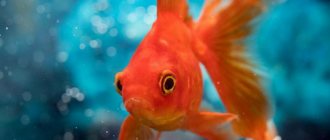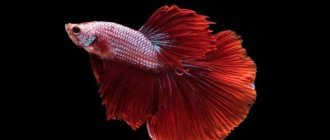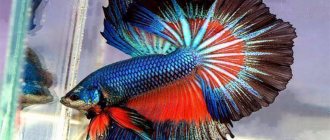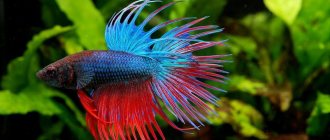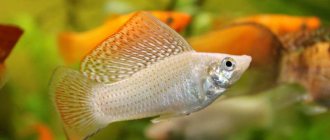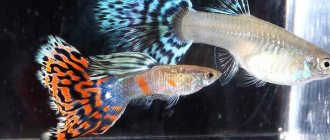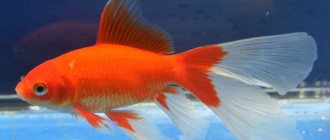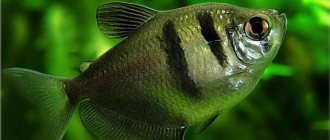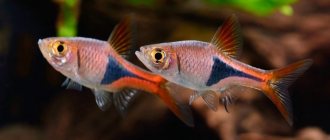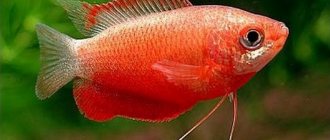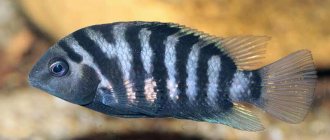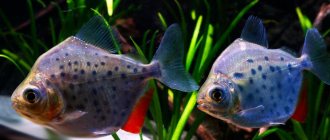Cockerel
The cockerel is an amazing fish in many ways. Its appearance, labyrinthine breathing and nest building undoubtedly captivate hobbyists. But how to create suitable conditions for the prosperous life of this extraordinary fish. The first thing you need to know about the betta fish is how to feed it.
In the wild, a betta is constantly in search of food, which means it spends a lot of energy. Therefore, wild bettas must consume more food than aquarium bettas, because... the latter move less and do not waste energy searching for food.
a brief description of
One of the most unpretentious fish known to hobbyists is the betta. The Siamese fighter is able to live in an ordinary cup. Just don't experiment on the poor guy. This is for general information.
Males are much more beautiful than their girlfriends, multi-colored, with bushy tails and disgusting characters. The females are gray, rather inconspicuous, and calm. Keeping two males is almost impossible, because the guys will definitely start fighting for territory. Such fights end with the death of one of the males. In addition, placing a girlfriend with a boy should be done quite carefully. The cockerel is capable of beating the bride to death.
Varieties of betta fish
Modern aquarium fish have come a long way in breeding work. These beauties with amazing outfits are very different from their wild ancestors with a nondescript dull green color and small fins. There are more than 70 different types of betta fish, which are divided into two large groups: by color and by the shape and size of the caudal fin.
So, depending on the colors and patterns, among the Siamese cockerels there are:
- monocolor (one-color individuals) – there are all kinds of color options;
- bicolor (two colors with and without a pattern) - there are breeds in which the body is one color and the fins are another;
- multicolor - the most beautiful are those with a smooth color transition.
Looking at representatives of different breeds, you can see how different these fish can be. Siamese bettas are one of the most successfully bred aquarium fish.
Based on the shape of the fins and body, the following are distinguished:
- The veil-tailed betta is the very first artificially produced variety of aquarium betta. The tail of such fish beautifully “falls” down like a veil;
- Crescent cockerel (Halfmoon) - these cockerels have a large veiled tail fin in the shape of a semicircle, as well as lush upper and side fins. There are several subspecies of halfmoon: half-sun, feathertail, rosetail;
- crowntail - the “plumage” of the fish resembles a royal crown;
- two-tailed cockerel - the tail fin of such fish is divided in half;
- round tail - the tail is small, round in shape, reminiscent of wild relatives;
- brush-tailed or spear-tailed cockerel - the tail is small, characteristically shaped like a brush;
- poster - they have a short, wide tail, as well as a long and wide lower fin;
- delta - the tail of these fish resembles the Latin letter delta;
- royal cockerel - so named because of its large size: from 6 to 8 cm;
- Dragon cockerel - the fish has a massive body with large hard scales, as well as large hard fins;
- elephant ear (Dumbo) - owners of very large circumbranchial fins, similar to elephant ears. Combtail. The fins of representatives of this breed look like a comb.
Content
It is worth talking separately about the care and maintenance of betta fish. It all starts with choosing an aquarium. Many hobbyists prefer a small round tank with artificial plants. The minimum volume required by its occupant is three liters. However, it is advisable to purchase a larger aquarium - from five liters. We remember that the fish is a loner and perceives new additions as a threat to its territory. And he deals with him quite harshly.
So, the aquarium is selected and installed in the designated place. By the way, about the installation. The tank should be located in a warm place, away from direct sunlight and drafts. Whether it is worth using a background for an aquarium is something everyone decides for themselves. The caveat is that gluing a beautiful background onto a round tank is quite problematic.
It is worth using artificial stones as soil for an aquarium. The fact is that natural soil is difficult to clean, but it is enough to wash the stones once a week, and remove dirt with a siphon every three days.
Live plants are suitable as food for betta fish. Joke! It is better to plant artificial plants in a round aquarium, because live ones require a filter. The fish is quite capable of living without a filter, heater and other paraphernalia. The fighter breathes ordinary oxygen, so the aquarium is kept open.
History of appearance
Beta is the oldest freshwater species kept in captivity after the Goldfish. Aggressive fish were discovered in the 19th century. in Siam and in reservoirs in southeast Asia. Enterprising aquarists, crossing wild cockerels, got “biting fish”, which they called Pla Kat. Betta splendens has been named since 1909.
Appearance
Betta fish are labyrinthine fish with an oval, laterally flattened, and elongated body. The length is 4-6 cm, sometimes a betta fish of 10 cm is found. The tail of the cockerel, similar to a lush veil, and the upper fins are rounded, and on the chest they are pointed. The line of the lower fin runs along the entire abdomen.
The color of the rooster fish is varied: some are completely one color, others are two-colored, and others are multi-colored, like a rainbow.
Where do they live in nature?
The betta fish chooses warm and shallow fresh water bodies for its habitat, even puddles, often muddy and polluted, muddy rivers where the current is slow. Betta fish are found in rice fields flooded with water without oxygen, and sometimes even inhabit drains. The cockerel is a fish that has adapted to breathe air from the atmosphere with the help of a labyrinth - a special organ. The cockerels were born in the reservoirs of Southeast Asia.
Fish fights
Male betta fish do not tolerate rivals in a small territory, and start fights when the loser must die. When attacking, the cockerels open their mouths wide and sink their sharp, thin teeth deeply into the body of their fellow. The winner does not allow the defeated fish to take a breath of fresh air and it dies.
Care
Before we talk about what food it is advisable to choose for your betta fish, let’s talk about caring for the aquarium and its inhabitants.
A small aquarium is cleaned every three to four days. Complete cleaning with water changes up to 85% occurs once a week. The cockerel is transplanted into another container, the soil, plants and shelters, if any, are removed and washed. Just be careful! Fish live in sedimentary water. Settling is carried out in open, clean jars or bottles and lasts 5-7 days. If this is not possible, you can use a water purification conditioner sold at a pet store. Pay attention to the products of the German company Tetra. Despite the cost, it is very high quality.
What is a siphon? This is a tool for cleaning aquarium soil. There are several types, we recommend purchasing the simplest one. Two tubes, and in the middle there is a pear, this is how this siphon can be characterized.
How to wash plants and soil? First, in running warm water, then the paraphernalia is rinsed in settled water or water purified with conditioner.
Where should I place the fish? Yes, at least in a clean cup. Only the water in which the betta will be should be from the aquarium. By the way, about the temperature of the replacement water. Be sure to wait until the water is at room temperature. It is unacceptable to put a fish in ice water, because the pet can float up with its belly.
Errors
Common mistakes made by aquarists:
- Beginners often feed a cockerel, which does not refuse food, even if it has eaten too much. In addition, due to large portions, the water quickly becomes cloudy.
- Monotonous diet.
- Neglecting herbal supplements.
- Lack of cleaning after feeding. Uneaten food falls to the bottom, where it rots over time, reducing water quality.
It happens that the cockerel does not react to the food or spits it out. Reasons for refusing food:
- the fish is sick;
- food particles are not the right size;
- the cockerel is not accustomed to a particular dish;
- The product offered is of poor quality.
Feeding
So we got to the types of food for betta fish. Our aquarium warriors love to eat, and modern technologies allow us to produce fish food for every taste and color. There are several types of food for betta fish.
- Dry. This includes flakes and granules.
- Frozen. Bloodworms, daphnia, brine shrimp, glassy and common worms.
- Live food, in our case - small bloodworms and worms.
- Green food, which means lettuce and spinach leaves.
About dry food
What is the best food for betta fish? There is no exact answer to this question, because nutrition must be combined. If you choose from dry food, then you should pay attention to small granules made in Germany. Tetra - that's the name of the company - produces the ideal food for fish. The products are sold both in cans of various sizes and by weight. It is better to purchase food in packages, as they retain their freshness longer. The flakes may be too large for the underwater inhabitant; they are crushed between the fingers. An excellent food for betta fish is granules. It is worth giving preference to multi-colored small granules, because this type of food is mixed. Plant ingredients are combined with animal products.
Green feed and meat
Readers will be surprised, but food for betta fish includes boiled beef or chicken heart, chicken gizzards, shrimp and squid. All products are boiled, divided into small pieces and given to the fish. Spinach and lettuce are used as green feeds as mentioned above. They are scalded with boiling water, small pieces are torn off and placed in an aquarium.
DOES A COCKER NEED VITAMINS?
Constantly giving vitamins to aquarium fish does not make sense. Vitamins are given to fish only in some cases. For example, if the fish is stressed due to a move, the addition of a new resident to the aquarium, or the death of an old resident.
In these cases, to support the betta, you can purchase special vitamins for fish at a pet store and give them according to the instructions. There are additives that are simply added to the aquarium water or those that are included directly in the fish’s menu.
Feeding frequency
Now let's talk about how often to feed your betta fish with dry food, frozen and regular. Dear readers, remember one rule! The cockerel is fed twice a day, the fish must eat a portion in two minutes. The faster the fighter finishes with the food, the better for the aquarium. Residues of food settle to the bottom, begin to rot, and in the absence of a filter, the consequences can be sad for the betta. That is why a small aquarium is cleaned every three days, but now we are not talking about cleaning, but about feeding.
When the cockerel feeds on pellets, you need to count out 5-7 pieces and give them one at a time. Swallowed? Got more. In the case of cereal feeding, the eating time is indicated above.
Do you give frozen food, fresh or natural? Replace one feeding with a dry product. Pieces of food should be small, remember this.
An overfed fish swells up like a balloon. The betta can swim on the surface, gasping for air, or “hang” in the middle of the aquarium. The owner will learn about overfeeding by paying attention to the fish’s belly. When the belly is swollen, a black dot below is clearly visible - the cockerel has overeaten.
Reproduction
Males mature quickly and are considered sexually mature at the age of 4 months, and begin to reproduce at 6-8 months. A pair of the same breed, and preferably the same color, is suitable for breeding.
Preparation for spawning takes several stages:
- For spawning it is better to equip a separate aquarium. A 4-5 liter tank with a water level of no more than 10-12 cm is suitable. Soil is not placed at the bottom, but plants are needed. The female creates shelter in them, and the male often uses them to build a nest.
- It is advisable to separate the female and male from each other for a week, during which time the female’s abdomen will noticeably become rounder.
- Then the fish are allowed into the spawning aquarium and their temperature is constantly raised to 28-30°C, this stimulates spawning.
- The male will begin to build a nest of foam on the surface of the water, which takes him from 1 to 3 days. If the pair is selected successfully, spawning will begin within a couple of hours.
- During spawning, the male courts the female, picks up the eggs and carries them to the nest.
After the end of spawning, the male drives away the female (she needs to be removed), and he himself takes care of the eggs in the nest: adding bubbles, removing unfertilized eggs. When the fry hatch and begin to swim, the male also needs to be removed, otherwise he may crush the fry.
During one spawning, 200 eggs are released, about a third of them survive.
